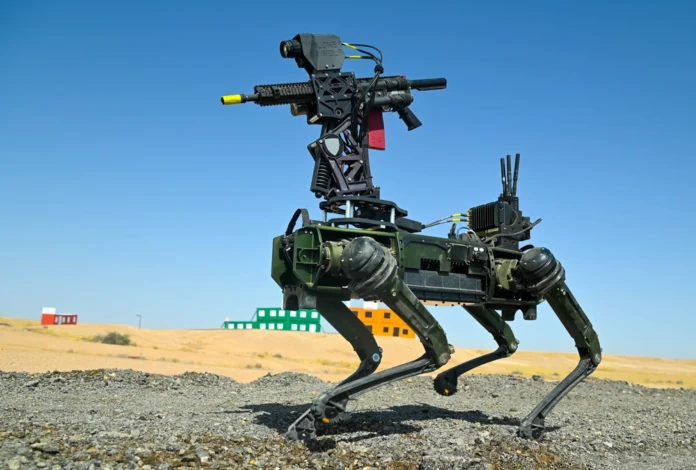
This post is also available in:
 עברית (Hebrew)
עברית (Hebrew)
Recent reports indicate that the U.S. military has been testing rifle-equipped robot dogs at the Red Sands Integrated Experimentation Center in Saudi Arabia. The robotic units are believed to be Ghost Robotics’ Vision 60 quadrupedal unmanned ground vehicles (Q-UGVs), potentially armed with AR-15 or M16 rifles.
During these trials, the Q-UGVs engaged static ground targets; however, the specific results of these tests have not been disclosed. The robot dogs are part of a broader strategy to enhance military capabilities, particularly in anti-drone operations. Notably, similar Q-UGVs were showcased during Operation Hard Kill at Fort Drum, New York, led by the Army’s 10th Mountain Division in collaboration with the Development Command-Armaments Center (DEVCOM-AC).
The Vision 60 Q-UGV is designed to adapt rapidly to various environments, utilizing a proprietary control system that mimics animal movement. This adaptability ensures that even in unknown or challenging terrains—where vision sensors may degrade—the robot can recover from slips or falls and continue its mission.
One of the critical features of the Vision 60 is its anti-drone capabilities. Equipped with a small turret and the abovementioned rifle, the Q-UGV can identify aerial threats using thermal and infrared vision. The rifle is paired with an electro-optical targeting system dubbed “Lone Wolf,” enhancing its precision in target engagement. A laser aiming device is also integrated into the system, providing added accuracy.
Remote control of the Q-UGV’s weaponry appears to be facilitated by tablet-like devices, allowing operators to manage the robot’s functions with precision. While details on automated targeting features remain unclear, the potential for such capabilities would significantly enhance its effectiveness in countering drone threats.
The United States Marine Forces Special Operations Command (MARSOC) is also reported to be testing armed versions of the Vision 60, while other conventional Marine units experiment with different robot types equipped with anti-armor rocket launchers. These advancements reflect a growing interest in deploying robotic systems to enhance battlefield capabilities against emerging aerial threats.

























